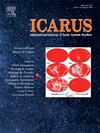Rock suites of Endeavour crater, Mars: Comparing Perseverance Valley, Spirit of St. Louis, and Marathon Valley
IF 3
2区 物理与天体物理
Q2 ASTRONOMY & ASTROPHYSICS
引用次数: 0
Abstract
Perseverance Valley is an erosional feature with the appearance of an eroded gully, located in the western wall of the Noachian aged Endeavour crater in Meridiani Planum, Mars. It is the most lithologically diverse location investigated by the Opportunity rover other than Cape York, where the rover first characterized the pre-, post-, and syn-depositional lithologies of Endeavour crater. We use hierarchical clustering and a similarity index combined with examination of Panoramic camera and Microscopic Imager images to classify these rock suites in Perseverance Valley, and contextualize them with comparison to rocks examined previously along the rim of Endeavour crater. The Perseverance Valley lithologies are classified into four rock suites, a clast-poor impact breccia that forms the “walls” of the valley, a competent basaltic outcrop of rocks that appear “blue” in false color Panoramic camera imagery, an outcrop of pitted rocks that has among the highest silica concentrations investigated by Opportunity, and a loose regolith mixture of martian soil, impact breccia, and local “blue” rocks that makes up the valley floor. Macro and micro textures indicate that the valley is currently being eroded by wind exiting the crater basin from west to east. Units that are offset both within and across Perseverance Valley indicate that the valley location and structure is likely influenced by a system of radial impact faults. Lithologies such as the co-located “blue” (in false color) and silica-rich pitted rocks, and observations of aqueous alteration such as “red” (in false color) zones, show similarities between Perseverance Valley and both Marathon Valley and the Spirit of St. Louis feature. We explore multiple working hypotheses to explain the formation mechanisms of Perseverance Valley, but can now say: the valley is likely structurally controlled including an ∼80 m vertical offset by a graben; the valley hosted local aqueous alteration; the floor material of the valley consists of mass-wasted local materials; and the current topographic expression was overprinted by modern aeolian erosion.
火星奋进陨石坑的岩石套房:比较毅力谷,圣路易斯精神和马拉松谷
毅力谷位于火星子午线平原诺阿契亚时代的奋进陨石坑的西壁,是一个侵蚀性的特征,外观上是一个侵蚀的沟壑。这是除了约克角之外,机遇号火星车调查过的岩性最多样化的地点。约克角是机遇号火星车首次对“奋进”陨石坑前、后和同沉积岩性进行表征的地方。我们使用分层聚类和相似性指数,结合全景相机和显微成像仪图像的检查,对毅力谷的这些岩石组进行分类,并将它们与之前沿着奋进陨石坑边缘检查的岩石进行比较。毅力谷的岩性被分为四组岩石,一组是形成山谷“壁”的碎屑差的冲击角砾岩,一组是在假彩色全景相机图像中呈现“蓝色”的强大玄武岩露头,一组是由坑状岩石组成的露头,这是“机遇号”调查过的二氧化硅浓度最高的露头,还有一组是由火星土壤、冲击角砾岩和当地“蓝色”岩石组成的松散风化层混合物,构成了谷底。宏观和微观结构表明,目前山谷正受到从西向东从火山口盆地吹出的风的侵蚀。恒心谷内部和山谷两侧的偏移表明,恒心谷的位置和构造可能受到径向冲击断层系统的影响。位于同一位置的“蓝色”(假色)和富含硅的蚀变岩等岩性,以及对“红色”(假色)带等含水蚀变的观察,显示出毅力谷与马拉松谷和圣路易斯精神谷特征之间的相似之处。我们探索了多种工作假设来解释毅力谷的形成机制,但现在可以说:山谷可能受到构造控制,包括由地堑垂直偏移约80米;山谷中有局部的水蚀变;山谷的地面材料由大量浪费的当地材料组成;目前的地形表现是由现代风蚀作用叠加而成的。
本文章由计算机程序翻译,如有差异,请以英文原文为准。
求助全文
约1分钟内获得全文
求助全文
来源期刊

Icarus
地学天文-天文与天体物理
CiteScore
6.30
自引率
18.80%
发文量
356
审稿时长
2-4 weeks
期刊介绍:
Icarus is devoted to the publication of original contributions in the field of Solar System studies. Manuscripts reporting the results of new research - observational, experimental, or theoretical - concerning the astronomy, geology, meteorology, physics, chemistry, biology, and other scientific aspects of our Solar System or extrasolar systems are welcome. The journal generally does not publish papers devoted exclusively to the Sun, the Earth, celestial mechanics, meteoritics, or astrophysics. Icarus does not publish papers that provide "improved" versions of Bode''s law, or other numerical relations, without a sound physical basis. Icarus does not publish meeting announcements or general notices. Reviews, historical papers, and manuscripts describing spacecraft instrumentation may be considered, but only with prior approval of the editor. An entire issue of the journal is occasionally devoted to a single subject, usually arising from a conference on the same topic. The language of publication is English. American or British usage is accepted, but not a mixture of these.
 求助内容:
求助内容: 应助结果提醒方式:
应助结果提醒方式:


